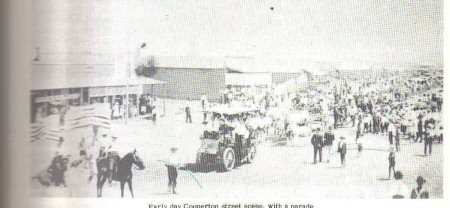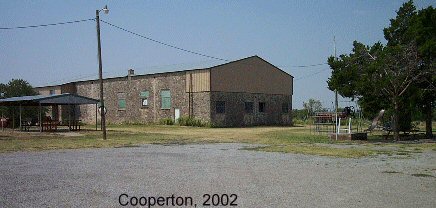COOPERTON, OKLAHOMA

THEN

NOW
Cooperton is located 9 miles east of Roosevelt and was named for Captain Frank
Cooper, a member of the David L. Payne Boomer Colony in the Cherokee Outlet.
According to one geology theory, the divide north of Cooperton between the limestone
mountains (commonly called the Slick Hills) and the Wichita Mountains was the
end of the ice age. The Slick hills were called that because they had little
or no timber growing, while the Wichitas were covered. The huge sea of ice moved
like a giant bulldozer moving everything in front of it and when it got to the
Wichitas, dropped it's load. Time allowed the soil to level forming Cooperton
Valley.
The town was planned in 1899 and the company formed by Frank
Cooper a former CSA captain had 300 members. He thought the
Kiowa-Comanche-Apache reservation would be opened by a "run" and when it wasn't,
he asked for and received 320 acres set aside for his people as a townsite. At
the time the country was covered with Grama and Blue Stem grass, the creeks were
full of water and fish and bears were numerous. Cooperton was a trading post,
consisting of 2 or 3 tents and a one room building under construction. The
building was used as a doctor, dentist and assay office. The post office was
established in Feb. 1901.
It grew to a general store, livery stable,
feed yard, lumberyard and a bank. By 1903, it also had a cotton gin, cigar
factory, blacksmith shop, churches and school. A weekly newspaper "The Banner"
was published. The town is surrounded by rich farming country. Due to mechanized
farming, highly inflated farm prices, good roads and better transportation by
truck many people moved from Cooperton. The high school closed in 1965 and the
grade school in 1972.
Return to Main
Page
Copyright, 1998-2008
This information compiled, prepared and submitted to this site by Ethel Taylorand remains the property of the
submitter
NOTICE: Ethel Taylor grants that this
information and data may be used by non-commercial entities, as long as this
message remains on all copied material, for personal and genealogical research.
These electronic pages cannot be reproduced in any format for profit, can not be
copied over to other sites, linked to, or other presentation without written
permission of Ethel Taylor.

